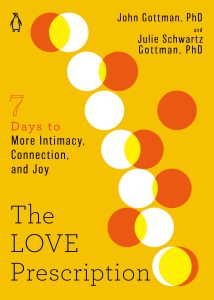So what happened with Grace and Andrew? Those two had a solid foundation. But they were losing ground. They wanted more time for sex, for contact, for intimacy, but they didn’t have the time, and they weren’t making time. Their lives had split into two parallel lives—Andrew was at the base, doing his classified work; Grace was home setting up fingerpaints and teaching little fingers how to play chords on the guitar. In the evening, it was a sprint: to get dinner made, to get everybody bathed and in bed, and then to loop back to the computer for the inevitable final round of emails or paperwork. The bills, the dishes, the pets, the laundry. Sometimes, in the evening, they’d settle down to watch a favorite show on Netflix, one about a couple who has the most extreme long-distance relationship you could ever imagine: she’s an astronaut on a three-year mission to Mars; he stays home at mission control and raises their daughter. Even when watching this show, they’d end up on separate pieces of furniture instead of together—Grace under a blanket on the couch, Andrew in an armchair across the room.
That their sex life seemed lackluster was a problem, sure, but it was the canary in the coal mine. They missed each other.
We worked on emotional connection. But they really needed the connection of physical touch to span the distance being created by their busy, separate lives. So what we started working on was mini-touches. Little quick touches as they were running by each other. A quick kiss. A squeeze on the shoulder. A hug.
We worked on how they welcome each other at the end of the day. This was the plan we came up with: whoever arrives home second (often it was Andrew, arriving from work, but sometimes it would be Grace and the kids coming home from errands or school pickup) throws open the door and announces, “I’M HERE!” And the first comes to the door and greets them with a hug and a kiss.
They loved it. It was fun. It was funny! The kids got into it. They loved to run in the door and scream, “I’M HERE! I’M HERE!” They loved their parents standing in the middle of the chaos, giving each other a long hug.
They began to find all kinds of times to add in rituals for physical connection. In the morning, they started saying goodbye with a kiss—even if Andrew left early, he’d kiss her while she was sleeping. A German study, discussed in the book The Science of Kissing, found that men who kiss their wives goodbye in the morning live five years longer than men who don’t. Good night rituals are also wonderful whether you have sex that night or not. How else do you say good night to your partner? Kiss, hug, hold each other for a while and talk until everybody’s drowsy and ready for sleep? This can be a sweet moment.
A recent study looked at 184 couples and investigated the link between emotional attachment and physical “touch satisfaction.” The focus was on nonsexual intimate touch: hugging, hand-holding, cuddling, and such. Unsurprisingly, they did indeed find a strong link. But what was really interesting is that people were all over the map in terms of touch needs and touch anxiety (wanting more than they were getting). But even when people reported that they weren’t getting as much touch as they would like, their relationships were improved when they saw their partner making an effort. In other words, just seeing and feeling your partner making a point to reach out and connect physically was enough to give love a boost.
In the Love Lab, with those three thousand couples we observed, the patterns of physical connection were clear. The successful couples—the ones who were still happily together six years later—were the ones who touched each other affectionately while they were cooking, cleaning, talking about the weather. They were the ones who held hands; the ones who touched each other encouragingly, even as they worked through a conflict; the ones who leaned toward each other rather than away, so that if you were to draw a line straight down from the crown of each of their heads, those lines would always be in the process of coming together, like the two descending sides of a drawbridge, about to connect.
From The Love Prescription by John Gottman, PhD and Julie Schwartz Gottman, PhD published by Penguin Life, an imprint of Penguin Publishing Group, a division of Penguin Random House, LLC. Copyright © 2022 by John Gottman, PhD and Julie Schwartz Gottman, PhD

The Love Prescription: Seven Days to More Intimacy, Connection, and Joy is available from Amazon and Bookshop.
